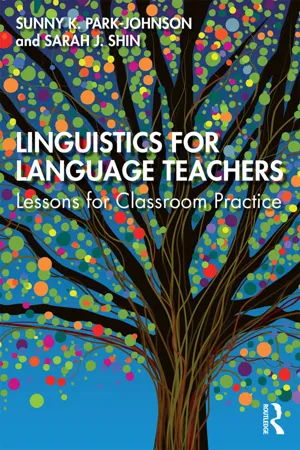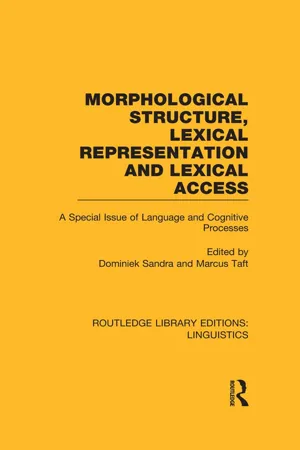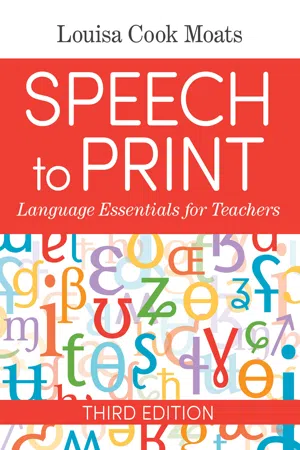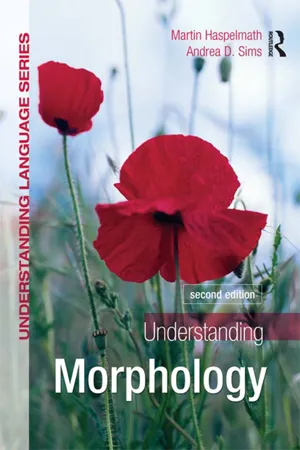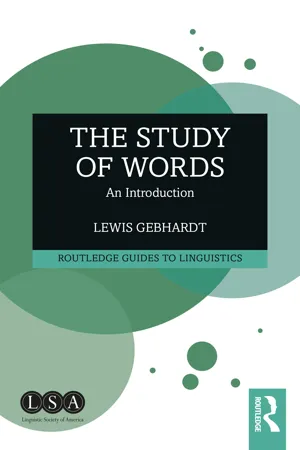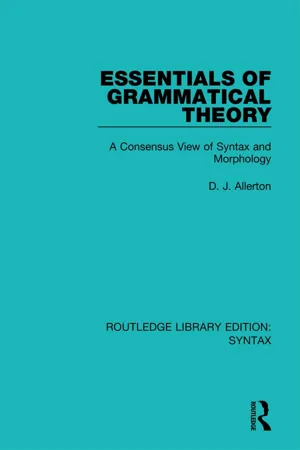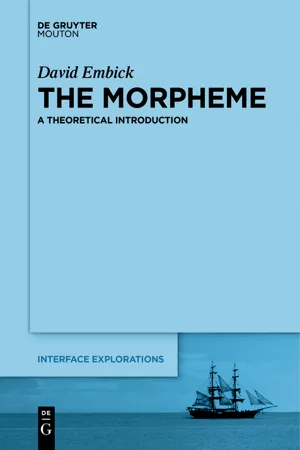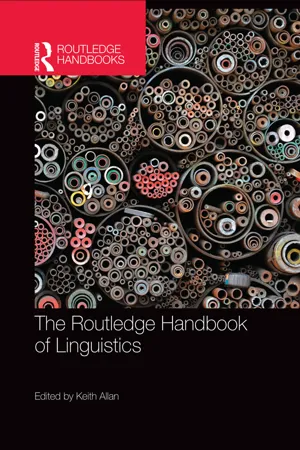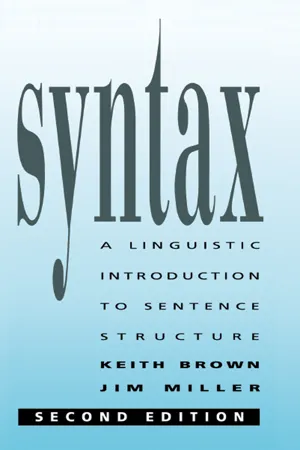Languages & Linguistics
Morphemes
Morphemes are the smallest units of meaning in language. They can be words or parts of words, such as prefixes, suffixes, and roots. Understanding morphemes is essential for analyzing the structure and meaning of words in different languages.
Written by Perlego with AI-assistance
Related key terms
11 Key excerpts on "Morphemes"
- eBook - ePub
Linguistics for Language Teachers
Lessons for Classroom Practice
- Sunny Park-Johnson, Sarah J. Shin(Authors)
- 2020(Publication Date)
- Routledge(Publisher)
In this chapter, we will analyze word structure by identifying each of the components and classifying them in terms of their contribution to the meaning and function of the larger word. We will see how words are formed in different languages, and how they are marked differently to show grammatical concepts such as number, tense, person, gender, and case. This chapter will show how knowledge of the principles of word formation can facilitate students’ learning of new vocabulary and what teachers can do to help students acquire this knowledge.4.2 Morphemes
The most important part of the word is the morpheme, the smallest linguistic unit with a meaning or a grammatical function. Morphemes are important because all languages use them as building blocks to construct words. The word teacher, for example, consists of two Morphemes: teach (with the meaning of “give instruction in”) and -er (which indicates that the whole word functions as a noun with the meaning “one who teaches”). Similarly, the word schools is composed of the Morphemes school (with the meaning of “an institution where instruction is given”) and -s (with the meaning “more than one”).Some words are made up of a single morpheme. Such words are said to be simple words. For example, the word happy cannot be divided into smaller parts that carry information about its meaning or function. Thus, the word happy consists of a single morpheme. In contrast, the word impersonal is made up of three Morphemes, im-person-al. Words that contain two or more Morphemes like impersonal are said to be complex words. It is important to not confuse Morphemes with syllables. The word happy [hæ.pi] is one morpheme but has two syllables. The word impersonal [ɪm.pʌr.sə.nəl] is composed of three Morphemes but has four syllables (note that the “.” in the phonetic transcriptions marks syllable boundaries). Remember that a morpheme is the smallest linguistic unit with a meaning or a grammatical function.Complex words typically consist of a root morpheme and one or more affixes. The root is the primary lexical unit of a word that carries the most significant aspects of semantic content and cannot be reduced into smaller parts. Roots typically belong to a lexical category such as noun (man, nation, color, tree), verb (teach, form, make, think), adjective (honest, small, kind, quick), or preposition (about, in, to, from - eBook - ePub
Morphological Structure, Lexical Representation and Lexical Access
A Special Issue of Language and Cognitive Processes
- Dominiek Sandra, Marcus Taft, Dominiek Sandra, Marcus Taft(Authors)
- 2014(Publication Date)
- Routledge(Publisher)
In textbooks on morphology and in introductory courses to general linguistics, Morphemes are almost invariably defined as the smallest linguistic units of form and meaning. In accordance with this definition, an English word like boys is said to consist of the stem morpheme boy and the plural suffix - s, as these segments reveal a constant form-meaning relationship across the English lexicon. Examples attesting to their morphemehood are boyish, boyhood, boy's school, boy's book for boy and cats, mugs, dolls for - s. Can psycholinguists modelling the mental lexicon rely on this traditional definition of the morpheme for making proposals on the way polymorphemic words are represented? It is very tempting to answer this question in the affirmative. Indeed, the definition almost naturally suggests that morphology could be put to the purpose of reducing the amount of information to be stored for these words in the mental lexicon. Two variants of this idea are discussed below with respect to different types of polymorphemic words, and then the explanatory nature of the concept of representational economy is evaluated. The Mental Lexicon as a Morpheme Inventory If the above definition is correct, the morpheme rather than the word could be considered as the basic unit of lexical description. If words can be broken down into their constituent Morphemes and the latter behave as constants of form and meaning, it must be possible (even desirable) to treat words as simple integrations of morphemic units, at the levels of both form and meaning. Within such a “building-block” perspective, the word itself is epiphenomenal and uninteresting for a scientific study of the lexicon. Its formal and semantic aspects being rule-governed, it would seem to claim the same status in the lexical realm that sentences have in syntax - eBook - ePub
Speech to Print
Language Essentials for Teachers
- Louisa Cook Moats(Author)
- 2020(Publication Date)
- Brookes Publishing(Publisher)
They can be categorized by their language of origin and by their grammatical role. Classes of Morphemes A morpheme is the most elemental unit of grammatical form that has both sound and meaning. Morphos means “form or structure” in Greek; eme means an element or little piece of something. A morpheme may be one or more syllables, as in red, indigo, and crocodile, or a word or a part of a word, as in full, a word, versus - ful, a suffix. Morphemes can be sorted into two basic categories— free and bound (see Figure 5.1). 5 Free Morphemes can stand alone as words and do not have to be combined with other Morphemes, as in spite, woman, and elephant. Free Morphemes may be made up of one or more syllables. Free Morphemes, in turn, can be sorted into two broad syntactic categories that determine how we use the words in sentences— function words and content words. Function words are free Morphemes and include conjunctions (but), prepositions (below), pronouns (he), auxiliary verbs (was), and articles (a, an). Function words are a closed class of words because languages typically do not add words to these categories, or if they do, the additions or changes occur very slowly. For example, the English language is slow to adopt gender-neutral pronouns, in spite of societal changes in attitudes toward gender identity. Function words are limited in number, learned early, and provide grammatical structure for sentences. Figure 5.1. Classes of Morphemes in English. Content words, in contrast, are free Morphemes that carry the meaning of a sentence. Content words include nouns, verbs, adjectives, and adverbs. These are by far the largest categories of words in any language. Unlike function words, content words are invented frequently as a language evolves. The meanings of content words also change with time. Thus, content word categories are open, not fixed - eBook - ePub
Applying Linguistics in the Classroom
A Sociocultural Approach
- Aria Razfar, Joseph C. Rumenapp(Authors)
- 2013(Publication Date)
- Routledge(Publisher)
The concept of a “word” is fundamentally abstract. They are easy to see in writing because of the spaces we put in between them, but in rapid speech, they are not always so easy to identify. Sometimes we slur words together; sometimes we drop off parts of words. When we are teaching students about words and our focus is the ‘words’ themselves, then we might be losing sight of the more critical element: meaning. This is a tough balance to hold, for we want our students to attend to the typical speech style of, say, mainstream American English, but we also want them to develop competence in meaning, developing ideas, and effectively communicating them. Therefore, this chapter is really organized to help us understand how many of the overlooked processes in language-use demonstrate a linguistic competence on the part of our students that is not seen if they are only evaluated from the point of view of Standard American English. In fact, many of the “mistakes” our students make actually may provide us with deep insight into language learning.Morphemes and Morphological AnalysisIn linguistic talk, a “morpheme” is the smallest unit of language that is meaningful. In written language we can see words, either like the ones you are reading now or characters as in Chinese or hieroglyphics. There are conventional spellings or pictograms for those words, and we can recognize them when we see them. However, in spoken language, words work a little differently. In fact, there are multiple language systems that use Morphemes in a variety of ways. In English, for example, each word consists of at least one morpheme, but many words contain several Morphemes. Think of the word “cat.” When we teach our students to make this word plural we tell them the English rule is to add an “-s” to make “cats.” This basic rule is an example of how English combines two Morphemes into one word. The first morpheme is “cat” which we, in English, identify as a noun. The second is the plural marker, which we can add to most nouns to make plural. This constitutes a morphological rule. As we have said previously, linguistic rules are different from prescriptive rules found in school-based grammar books. For linguists, it is a rule because we can use it to describe how a language works, even though the rule is not always true. We could call English, then, a fusional - eBook - ePub
- Martin Haspelmath, Andrea Sims(Authors)
- 2013(Publication Date)
- Routledge(Publisher)
2W e have seen that morphological structure exists if a group of words shows partial form-meaning resemblances. In most cases, the relation between form and meaning is quite straightforward: parts of words bear different meanings. Consider the examples in (2.1).(2.1) read read-s read-er read-able wash wash-es wash-er wash-able write write-s writ-er write-able kind kind-ness un-kind happy happi-ness un-happy friendly friendli-ness un-friendly These words are easily segmented, i.e. broken up into individually meaningful parts: read + s, read + er, kind + ness, un + happy, and so on. These parts are called Morphemes.1 Words may of course consist of more than two Morphemes, e.g. un-happi-ness, read-abil-ity, un-friend-ly, un-friend-li-ness.Morphemes can be defined as the smallest meaningful constituents of a linguistic expression. When we have a sentence such as Camilla met an unfriendly chameleon, we can divide it into meaningful parts in various ways, e.g. Camilla/met an unfriendly chameleon, or Camilla/met/an/unfriendly/chameleon, or Camilla/met/an/un/friend/ly/chameleon. But further division is not possible. When we try to divide chameleon further (e.g. cha/meleon), we do not obtain parts that can be said to be meaningful, either because they are not found in any other words (as seems to be the case with meleon), or because the other words in which they occur do not share any aspect of meaning with chameleon (cf. charisma, Canadian, caboodle, capacity, in which it would be theoretically possible to identify a word part cha/ca-). Thus, chameleon cannot be segmented into several Morphemes; it is monomorphemic. Morphemes are the ultimate elements of morphological analysis; they are, so to speak, morphological atoms.In this chapter we introduce some other fundamental concepts and their related terms, starting with lexemes and word-forms.2.1 Lexemes and word-forms
The most basic concept of morphology is of course the concept ‘ word’ . For the sake of convenience, let us assume for the moment that a word is whatever corresponds to a contiguous sequence of letters.2 Thus, in one sense the first sentence of this paragraph consists of twelve words, each separated by a blank space from the neighbouring word(s). And in another sense the sentence has nine words – there are nine different sequences of letters separated by spaces. But when a dictionary is made, not every sequence of letters is given its own entry. For instance, the words live, lives, lived and living are pronounced differently and are different words in that sense. But a dictionary would contain only a single entry LIVE . The dictionary user is expected to know that live, lives, lived and living are different concrete instantiations of the ‘ same’ word live. Thus, there are three rather different notions of ‘ word’ - eBook - ePub
The Study of Words
An Introduction
- Lewis Gebhardt(Author)
- 2023(Publication Date)
- Routledge(Publisher)
antidisestablishmentarianism in the first chapter. But language has way more than 118 basic elements. If we’re starting with the pieces that make up words, English, and presumably every language, has thousands of fundamental units, although no one knows an exact number – there probably isn’t an exact, static number. The grammatical system of combining the fundamental pieces of words gives us the tens of thousands of words in any language and the capacity to make as many more as we like. As one more part of the analogy with chemistry, yes, we could further divide these fundamental pieces into individual sounds, but because individual sounds typically don’t have any meaning or function in themselves, these word pieces are a better place to identify the atomic elements of wordformation. These atomic units are called Morphemes. What you have stored in your brain is not so much a list of words but a network of Morphemes.2.2 Morphemes and the Lexicon
We start with a standard presentation of what can be considered the minimal elements of meaning by offering a working definition of a morpheme.(1) Morpheme: Preliminary DefinitionA morpheme is a minimal sound-meaning pair in language. A morpheme links a chunk of sound to a meaning. Thus, a morpheme is not so much a thing but, rather, is a relationship, an association. The association between sound and meaning in any language is overwhelmingly arbitrary, meaning that there’s no natural connection between the sounds that make up a morpheme and the meaning of the morpheme. The sound sequence in cat, [kæt], has nothing to do with felines, nor do the cat-denoting Morphemes in other languages, such as Japanese neko [nɛko], Persian gorbeh [gɔrbɛh], French chat [ʃa], or Crow kilía [kilia]. Because the relationship between sound and meaning is arbitrary, we say, in the philosopher Peirce’s terms, the sounds are symbols. Memorizing which sounds symbolize which meanings is a major task in learning any language.The association between sound and meaning is minimal in the sense that Morphemes cannot be further analyzed into meaningful pieces. The word blackened has three easily recognizable Morphemes: black, -en and -ed. Starting from the left, black has something to do with the color; we can say that black denotes the color black; it’s typically used as an adjective. The -en part takes the adjective black and converts it into a verb, adding the meaning of something like ‘become’ or ‘cause to become’. Thus, blacken can mean ‘cause to become black’. This -en appears in other words such as whiten, darken, sharpen, harden, lengthen, heighten, with the same causative meaning. Finally, now that -en has provided us with a verb, the -ed puts the verb in the past tense. Because it comprises smaller pieces in this way, blackened, as a whole, is clearly NOT a minimal sound-meaning pair, although each of the three pieces is. These pieces are as deep as we can go. For example, while the sound of black is analyzable into a sequence of sounds, the word cannot be meaningfully divided into, say, bl and ack, or bla and ck. How about b and lack? Well, lack IS a word, a separate morpheme, but that’s not what we have inside black. The word lack has nothing to do with black; it’s only an accident that the sound sequence in lack is the same as the sound sequence following the b in black. The word black is minimal and, therefore, a morpheme. Likewise, the -en and the -ed - eBook - ePub
- Kristin Denham, Anne Lobeck(Authors)
- 2018(Publication Date)
- Routledge(Publisher)
4 The study of words MorphologyLet’s now consider how we study speakers’ unconscious knowledge of word structure. In Chapter 2 , in the ‘Our knowledge of grammar’ section, we briefly discussed how our knowledge of word structure, or morphology, includes knowledge of Morphemes, or parts of words, and of affixation (suffixes and prefixes in English for example, and the roots and words they attach to). We also have knowledge of word formation rules such as clipping, blending, backformation, compounding, etc.As we will see in this chapter, languages don’t necessarily share the same morphological rules. Consider, for example, one type of word formation that doubles a part of the word (called reduplication) that occurs in Lushootseed, a language of the Pacific Northwest (adapted from Hess & Hilbert, 1995):ʔálʔal house ʔáʔálʔal hut ʔúqw’ ud pull out ʔúʔúqw’ ud pull part way out híwil go ahead híhíwil go on ahead a bit q’íxw upstream q’íq’íxw a little bit upstream The first two sounds of a word are doubled in order to make a diminutive: the ʔá of the word for house is doubled to make hut: ʔáʔálʔal.As we will also see in this chapter, there is much more to the study of morphology than making words. In fact, the question What is a word? is actually quite difficult to answer, because not all languages build words in the same way, yet speakers share some kind of common knowledge that allows them to recognize what is and what is not a possible word in their language.MorphemesA morpheme is often described as the smallest unit of meaning in a word. This suggests that there are two Morphemes in the word pancake, namely, pan and cake, both of which have rather obvious, recognizable meanings, and both of which are words by themselves. Other Morphemes have meaning too, though perhaps not in the dictionary sense. English speakers would probably all agree that there are three Morphemes in waspishness (wasp, -ish, and -ness). We can say that the Morphemes -ish and -ness have meaning because we recognize them as parts of words we easily combine with other parts to create other words, such as pinkish and happiness. We also know that although -ish and -ness can attach to adjectives such as pink and happy, these suffixes can’t attach to verbs such as run or work to create *runnish or *workness. So, although we might have difficulty defining the term word - eBook - ePub
Essentials of Grammatical Theory
A Consensus View of Syntax and Morphology
- D. J. Allerton(Author)
- 2016(Publication Date)
- Routledge(Publisher)
Chapter 10 Morphological structureWords and Morphemes
In chapter 3 we described the morpheme as the basic unit of grammar. We saw how words like boys, inexpensive and fire-engine break down into Morphemes. Although we met problems in the case of unique Morphemes like cran- and of pseudo-Morphemes like the -appoint of disappoint, we worked with the idea of a morpheme as a minimum meaningful unit. We were, however, aware that Morphemes are lacking in precision, definition and independence compared with words. It is easy to assert that the element milit- has morphemic status in the words military, militant, militate, militia but equally easy to see that the meaning of the morpheme is not so definite that it totally predicts the meaning of the word.The word, itself, may be thought of as the minimum lexical unit, in the sense of the minimum unit with an independently usable meaning. But this will not quite do, since it leaves out of account the problem of idioms, such as catch a crab, ‘jam oars when rowing’, (run) hell for leather, ‘very fast, hurriedly’. Here we find that our minimum semantic unit is even larger than the word. So there must be more than just semantic factors at stake in the notion of WORD .The word (like the sentence) is apparently defined for us by the written language – at least for languages that have a written form. Writing systems are, however, generally not especially systematic in their traditional conventions for putting spaces between words. Consider, for instance, the following sets from English:matchbox firewood horse-box fire-engine telephone box fire insurance Every item is a compounding of two elements that could have been words in their own right but are here merged to give a compound which has a meaning that is more than just the sum of its parts. A telephone box - eBook - ePub
- David Embick(Author)
- 2015(Publication Date)
- De Gruyter Mouton(Publisher)
Chapter 1 Morphemes in the Grammar 1.1 Introduction At the most basic level of description, a grammar consists of a set of primitive elements and a set of rules for deriving complex objects out of these primitives. According to the view that is developed in this book, the primitive elements are Morphemes, and the system responsible for combining Morphemes into complex structures is the syntax. The syntax generates expressions that relate sound and meaning. In the particular model of grammar that is assumed here, sound- and meaning-specific representations are created by distinct sets of computations that apply to the objects derived by the syntax. The sets of computations related to sound and meaning are referred to as Phonological Form (PF) and Logical Form (LF); these are the interfaces of the syntax. My focus in this book is on the theory of the morpheme. This is one subpart of an area of investigation that is typically or traditionally called morphological theory. As mentioned above, the particular morphological theory that I will advance in this book starts with the assumption that Morphemes are syntactic objects—i.e., the terminal nodes of syntactic derivations—and proceeds from there to develop an account of how Morphemes are represented in memory, and of how they connect sound with a particular type of meaning (specifically, semantically interpreted features). Given the fundamentally syntactic orientation of this theory, it must be stressed from the outset that terms like morphology and morphological theory are used in this work in an informal sense: there are often no principled answers to questions about where “morphology” stops, and where e.g. “syntax” or “phonology” begin or end - eBook - ePub
- Keith Allan, Keith Allan(Authors)
- 2015(Publication Date)
- Routledge(Publisher)
apple . A lexeme is the abstract unit that stands for the set of inflectional forms of a word, and is usually represented with small capitals.The two basic functions of morphological operations that create complex words are (a) word formation and (b) inflection. Word formation processes create new words, and hence expand the lexicon of a language. Once the speaker of English has discovered the pattern exemplified in (1), (s)he may hit on a word formation schema which we can characterize, informally, as follows:(2) [[x]V er]N ‘Agent of action V’This schema states that nouns may consist of a verbal base of whatever phonological composition, followed by the suffix –er . The meaning correlation of this structure is a compositional function of the meaning of the base verb, and the agent interpretation is a property of this morphological configuration as a whole (the affix –er does not have a meaning by itself in isolation). The speaker may then use this schema to create new words with the appropriate form and meaning, such as skyper , derived from the verb (to) skype , or texter , derived from the verb (to) text . The new words may not only have the meaning predicted by the schema, but also additional idiosyncratic properties. For instance, the Urban Dictionary 2 defines a texter not just as someone who texts, but as ‘a person who prefers to send text messages instead of picking up the phone.’Instead of agent nouns, deverbal nouns in –er might also denote instruments, as in cooker , fastener and vacuum cleaner , and other meanings such as location (as in diner - eBook - ePub
Syntax
A Linguistic Introduction to Sentence Structure
- Keith Brown, Jim Miller(Authors)
- 2020(Publication Date)
- Routledge(Publisher)
mace may realize either the lexeme MACE(1) with the sense ‘spice’ or the lexeme MACE(2) with the sense ‘staff of office’ – a fact usually recognized in dictionaries by according each lexeme a different entry.2 In section 12.3 we distinguished between ‘word and paradigm’ and ‘item and arrangement’ models of morphology. In the former the grammatical word will generally be the head lexeme and its associated features (e.g. laughed:LAUGH[past] , or LAUGH[past part] ); in the latter the grammatical word will be a string of Morphemes (e.g. laughed: {LAUGH + past} or {LAUGH + past part}.3 The sentences are represented in the orthographic form. Tone markings have been omitted, although these are also relevant to a complete description of the verbal system. This does not affect the point at issue.Passage contains an image
13 Morphemes and morphs
In the previous chapter we established a distinction between Morphemes, abstract units used in the grammar, and morphs, concrete units that are ‘parts of words’. We described the relation between the abstract morpheme and the concrete morph as one of realization. In this chapter we look at different kinds of morphs and begin to explore realization.13.1 Morphs
When a word form can be analysed into smaller forms, which cannot themselves be analysed into yet smaller forms, the smaller forms are morphs. A morph is thus a word form (if it cannot be analysed) or part of a word form. In this section we introduce some terminology for talking about morphs.Word forms that can be analysed into a string of two or more morphs are morphologically complex. Word forms that consist of a single morph are morphologically simple; walk-ed is morphologically complex; went or ran is morphologically simple.A morph that can stand alone as a word is a free morph; boy, tea, time, half, back, happy and long are free morphs. A morph incapable of standing alone as a word is a bound morph: -ish, un-, -ed and -ness in boy-ish, un-happy, walk-ed and good-ness are bound morphs. We show bound morphs preceded or followed by a hyphen: -ish, -un
Index pages curate the most relevant extracts from our library of academic textbooks. They’ve been created using an in-house natural language model (NLM), each adding context and meaning to key research topics.
